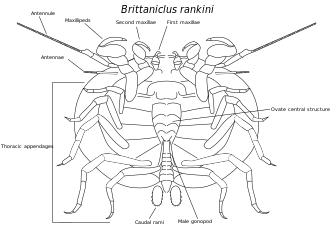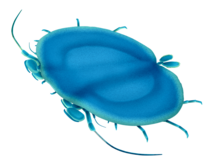Cyclida
| Cyclida Temporal range: (possible Cretaceous records)
| |
|---|---|

| |
| Diagram of Brittaniclus rankini (formerly Americlus rankini) in ventral view | |
| Scientific classification | |
| Domain: | Eukaryota |
| Kingdom: | Animalia |
| Phylum: | Arthropoda |
| Superclass: | Multicrustacea |
| Order: | †Cyclida Schram, Vonk & Hof, 1997 |
| Genera | |
|
See text | |
| Synonyms | |
| |
Cyclida (formerly Cycloidea, and so sometimes known as cycloids) is an extinct
Description

Cyclidans have a "striking" resemblance to
Affinities
There is considerable debate about the placement of cycloids within the
The first description of a cycloid was in the 1836 treatise Illustrations of the Geology of Yorkshire by
In an unpublished
Ecology
While most cyclidans are known from marine environments, a handful are known to have inhabited freshwater environments. Many marine species occupied reef habitats, while other are known to have lived in deep marine settings.[2] The anterior chelae like appendages are suggested to have been used for grasping and manipulating food items. Cyclidans are suggested to have had a similar ecology to modern crabs, including as detritivores, scavengers, predators and consumers of plant matter.[3] A parasitic mode of life has sometimes been suggested for cyclidans,[4] but this has been considered unlikely due to their large size and well calcified skeletons.[3]
Taxa and stratigraphy
Cycloids are known from deposits ranging from the Early
Families and genera
After Schweitzer, Mychko & Feldmann, 2020.[2]
- Family Schraminidae Dzik, 2008
- Schramine Dzik, 2008[4] comprises two species from the Carboniferous of North America and three species from the Early Triassic of Madagascar, some of which were formerly included in Halicyne.
- Opolanka Dzik, 2008[4] contains a single species found in Late Triassic rocks at Krasiejów in Poland.[4]
- Apionicon Schram, Vonk & Hof, 1997 is known from a single species found in Upper Carboniferous (Mazon Creek.[6]
- Family Cyclidae Packard, 1885
- Ambocyclus Schweitzer, Mychko & Feldmann, 2020 contains three species from the Carboniferous of Ireland, North America and Russia
- Prolatcyclus Mychko, Feldmann, Schweitzer & Alekseev, 2019 Contains two species from the lower Carboniferous of England and Russia
- Cyclus de Koninck, 1841 formerly contained 17 species found in Carboniferous deposits of Europe, Asia and North America, now defined to only include the species Cyclus radialis from the lower Carboniferous of Europe
- Carabicyclus Schweitzer, Mychko & Feldmann, 2020 known from two species from the Lower Carboniferous of the British Isles
- Litocyclus Schweitzer, Mychko & Feldmann, 2020 definitely two and possibly four species, known from the Lower Carboniferous of the British Isles and the Upper Carboniferous of North America
- Chernyshevine Schweitzer, Mychko & Feldmann, 2020 known from a single species from the Lower Carboniferous of Tajikistan
- Tazawacyclus Schweitzer, Mychko & Feldmann, 2020 known from a single species from the Lower Carboniferous of Japan
- Uralocyclus Mychko & Alekseev, 2018 contains two species from the Lower Carboniferous of the British Isles and the Earliest Permian of Chelyabinsk, Russia
- Family Halicynidae Gall & Grauvogel, 1967
- Halicyne von Meyer, 1844 contains six species from the Middle Triassic of Europe.[4]
- Carcinaspides Glaessner, 1969 contains a single species found in limestone rocks in the Isar valley of Bavaria (Germany) and is probably of Mid to Late Triassic age.[4]
- Juracyclus Schweigert, 2007 comprises a single species found in the Early Jurassic Posidonienschiefer near Tübingen, southern Germany.[1]
- Family Americlidae Dzik, 2008
- Americlus Dzik, 2008 contains A. americanus (formerly Cyclus americanus),Mazon Creek,[6]as well as two possible other species, the holotypes of which are now lost, which all known from the Late Carboniferous of North America.
- Yunnanocyclus Feldmann, Schweitzer & Hu, 2017 single species known from the Middle Triassic of China
- Brittaniclus Schweitzer, Mychko & Feldmann, 2020 Contains three species from the Carboniferous of Britain
- Dziklus Schweitzer, Mychko & Feldmann, 2020 Contains a single species known from the Upper Carboniferous of North America
- Malayacyclus Tang et al. 2021[11] Contains one species from the Lower Carboniferous of Malaysia
- Americlus Dzik, 2008 contains A. americanus (formerly Cyclus americanus),
- Family Alsasuacaridae van Bakel, Jagt, Fraaije & Artal, 2011 (Note: The placement of these taxa within Cyclida has been questioned, and some authors argue that these taxa may be true crabs instead).[3]
- Alsasuacaris van Bakel, Jagt, Fraaije & Artal, 2011 known from a single species found in late
- Maastrichtocaris Fraaije, Schram & Vonk, 2003 comprises a single species found in Maastrichtian (late Cretaceous) rocks from that period's type locality in the southern Netherlands.[9]
- Family Hemitrochiscidae Trauth, 1918
- Cyclocarcinides Glaessner, 1969 comprises 5 species known from the Upper Triassic of Europe
- Hemitrochiscus Schauroth, 1854 known from one species found in
- Oonocarcinus Gemmellaro, 1890 is known from 3 species from the Permian of Sicily and 1 species from the Late Triassic of Slovakia
- Paraprosopon Gemmellaro, 1890 is known from one species from the Permian of Sicily (Italy).[4]
- Skuinocyclus Mychko & Alekseev, 2018 comprises one species from the earliest Permian of Bashkortostan, Russia
- Incertae sedis
- Anhelkocephalon Bill, 1914 known from a single species found in the Middle Triassic of France, originally classified as an isopod.[13]
- Magnitocyclus Mychko et al. 2022, comprises a single species from the Lower Carboniferous of Russia.[14]
Further reading
- JSTOR 2450109.
References
- ^ S2CID 131620349.
- ^ S2CID 225865064.
- ^ ISBN 978-0-19-536576-4, retrieved 2023-01-22
- ^ S2CID 17617567.
- ^ .
- ^ S2CID 140725375.
- S2CID 160017485. Archived from the original(PDF) on 2010-07-21. Retrieved 2011-03-24.
- ^ John Phillips (1836). Part 2. The Mountain Limestone District. Illustrations of the Geology of Yorkshire. London: John Murray.
- ^ JSTOR 4094744.
- .
- S2CID 233522378.
- ^ Barry W. M. van Bakel; John W. M. Jagt; René H. B. Fraaije & Pedro Artal (2011). "A new family, genus and species of cyclid (Crustacea, Branchiura, Cyclida) from mid-Cretaceous reefal deposits in northern Spain" (PDF). Bulletin of the Mizunami Fossil Museum. 37: 47–49. Archived from the original (PDF) on 2011-07-21. Retrieved 2011-03-24.
- S2CID 219476736.
- S2CID 250706723.
